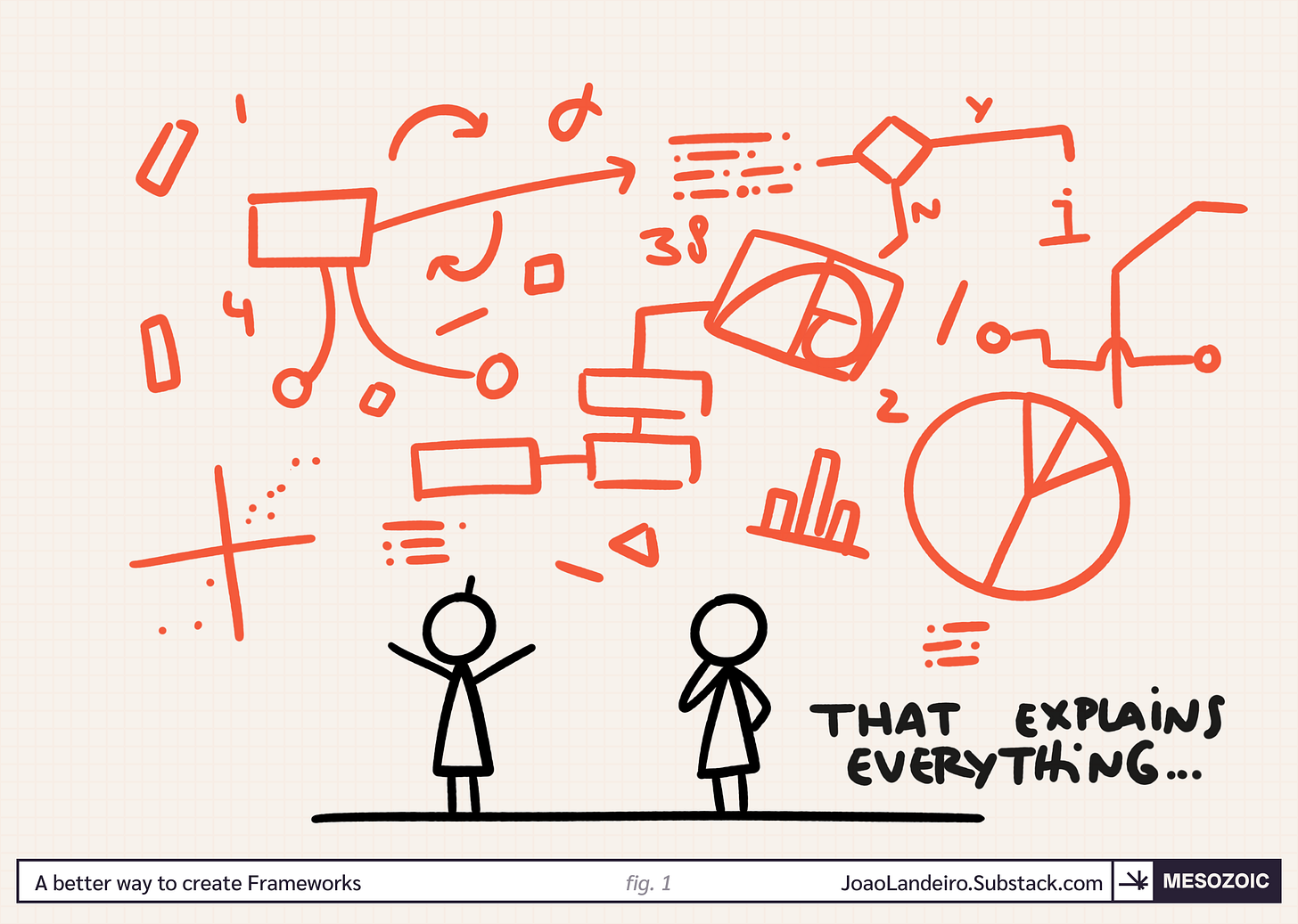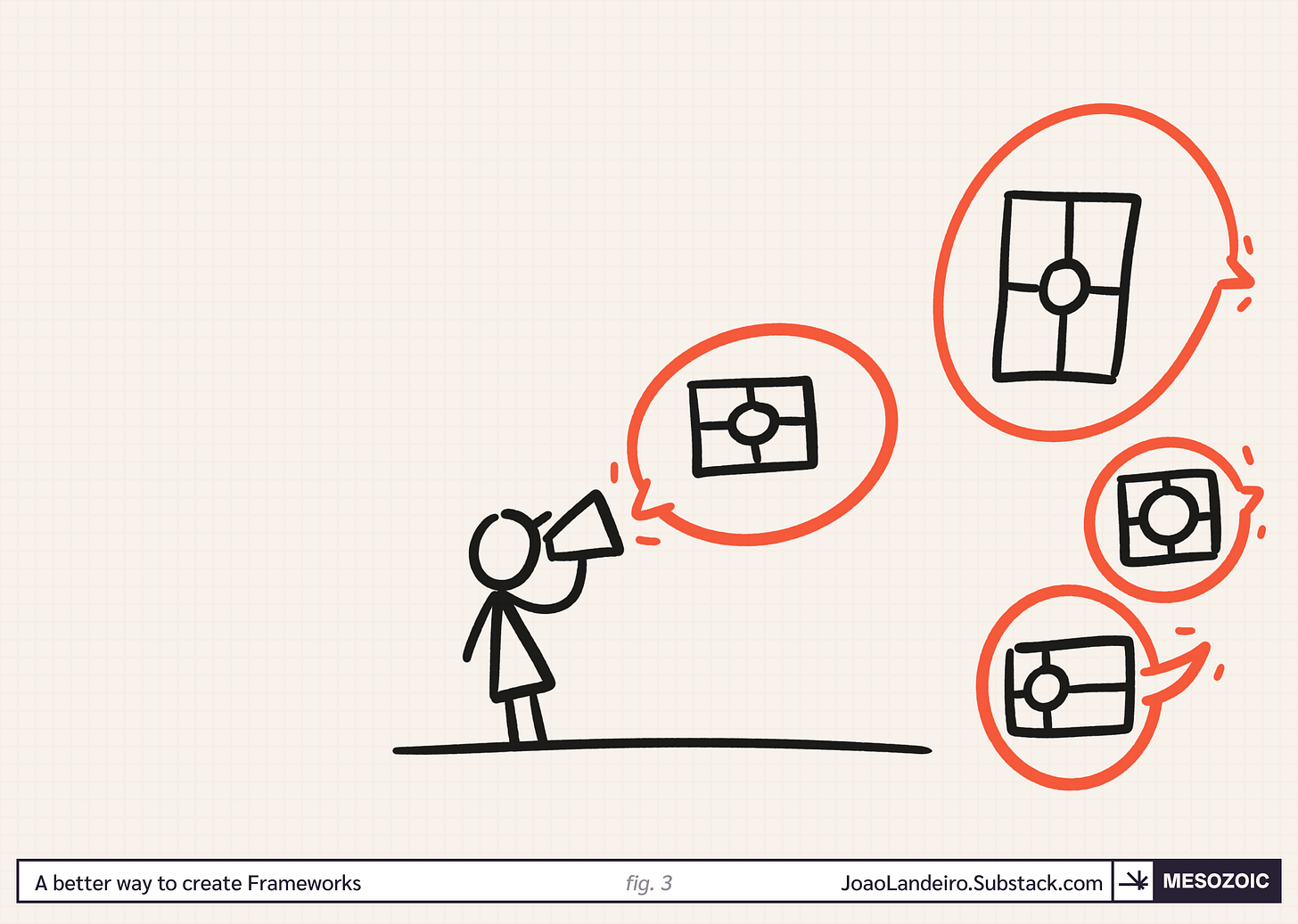A better way to create Visual Frameworks
why you need multiple visual frameworks, not a single large one
I like weird movies. And a movie that I really like is π.
The movie is great at expressing the frenzy of a mind that's grasping at infinity.
Shot in black-and-white, grainy footage, a soundtrack that's a mix between sandpaper and a supercollider.
The protagonist is searching for a number that explains everything.
Something like a God-number.
Just look at this trailer. Headphones on, please.
A fool's errand
This is a common theme in stories: the search for an ultimate answer that quiets all questions. A master key that opens every door.
We are curious beings that struggle with the unanswered so our mind looooves to close these loops.
And so, some of us try to come up with a general theory of our field of expertise. An all encompassing, all explaining elegant way of uniting every aspect of what we do. By bending disparate concepts into a cohesive shape and finding connections that no peer detected, we could be immediately transformed into rockstars of our fields.
Wouldn't that be sweet?
A hint: Every story I find that is about this search for an ultimate solution ends in a void. Either the seeker goes insane or disappears.
So let's take it easy on ourselves and aim lower. There's no point in sweating trying to get to a perfect equation of our domain of expertise.
The issue with unifying theories.
A single, unifying visual framework is either too vague to really mean anything (I'm looking at you Sinek) or too complex to be usable.1
But that's not the only issue with that.
When you focus too much on creating a single visual framework that explains everything in one picture, you bake in a lot of relationships. The way concepts are connected becomes rigid and because of that, brittle. Every all-encompassing framework is made obsolete the moment the pen hits paper.
The wonders of several small frameworks
4 reasons why I prefer smaller frameworks that focus on specific aspects of a person's work:
They are better to explain complex things, like what you do
They make it easy to talk about your work in many different ways
They allow for adaptation and iteration when circumstances change
They are more portable and easier for others to modify and improve upon
Your work is multi-layered
How do you think about what you do? How do you talk about it? In which contexts do you describe your method? Is it when comparing it to other methods or when you're presenting its core elements? Do you use analogy and metaphor?
It's impossible to compress specialized knowledge work 2 into one unique visual representation.
However, breaking down your work into different aspects makes it much simpler to visualize.
Some examples:
One picture to explain your general process
One picture to compare between two different approaches
One picture to present the tenets of your unique professional point of view
One picture to illustrate the journey your client moves through when they hire you
etc
You must communicate constantly what you do
This is a lesson that took a long time for me to absorb, but is now clear: to be recognized and remembered, we must constantly talk about what we do. 3
This can feel like Sisyphean work. But it's made much easier when you slice up your expertise into smaller parts, each of them focused on one aspect.
If you had an Ultimate-Equation-That-Solves-All to describe your work, you're quite limited in how much you can do with it. There's not a lot of variety there.
But when you have a set of tiny frameworks...
Your work is alive
As a lover of weird movies, it's not surprising that I think that our work has some adaptive emergent characteristics. It certainly doesn't stay still.
The stuff we do, the reasons why we do it and the way that we do it, change all the time.
Go back to a previous project of yours and notice the subtle differences in how you did things back then.
If your work keeps evolving, having an integrated theory of it all is not going to work. Either the work breaks the model or the model breaks the work. 4
But if you explain your work with a set of smaller visual frameworks, when one stops making sense, you can iterate on it. You can adjust it, upgrade it, throw it away or replace it. The way you talk about your work becomes modular.
When frameworks are adopted, they are also adapted
This is extremely important.
I repeat
This is extremely important.
When we create pictures and mental artifacts that explain our work, the moment they leave our heads, they begin mutating.
A person misunderstood our idea…
…another person added to it…
..a third person simplified it.
This process happens forever, sometimes at the speed of light.
And as versions of our insight spread out into the wild marketplace of ideas, a competition begins. The best versions of our insight will rise to the top.
And then we can re-integrate their evolved characteristics into our own set of small frameworks.
In other news:
I've run an intimate virtual workshop on “Selling the Invisible”. It was in Portuguese, but I might translate it and run it in English. I'd love to know if this something you'd be interested in.
I've organized some posts on my personal website. It's a good place to check that is not just about workshops.
I think I've invented a new thing in Miro. Could be fun
I've been thinking a lot about the idea of cognitive ergonomics. It matters a lot when creating visual frameworks.
anything that's not pure mathematics, actually
Who hasn't ever written a blog post that was supposed to be short and ended up trying to explain an entire profession? I have!
It's like what that guy said about immovable forces vs unstoppable objects. Or the other way around, maybe?





Based on what you’ve written here I think I am safe in equating a visual framework with a theory. The more territory covered by a theory, the greater the risk posed by anomalous observations that don’t fit the theory. As the theory approaches universality, the risk of new anomalous observations becomes existential. We have seen this over and over in history. And when universal theories collide, as they do sometimes, people who follow different ways have nothing useful to say to each other. All this to say I agree that mono-theories are dangerous. Consider the recent theory that all problems can be solved by design thinking.